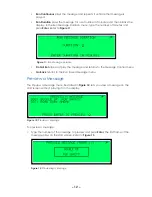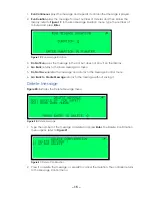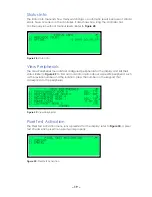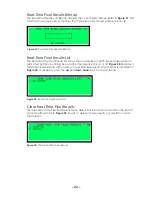
– 7 –
Auxiliary Control Port (J7)
The auxiliary control port can be used as a secondary control port or used to interface
to other devices, such as a UPS. The default configuration for this port is PMPP, no
handshaking, at 9,600 bps. Refer to
The control capabilities of this port depend on the state of the Local indicator LED on the
front interface panel. When the VFC-3000 controller is in local mode, the port is limited to
status retrieval information. When the VFC-3000 controller is in remote mode, it can fully
control the display.
Local Control Port (J1)
The local control port is an RS232 port used for temporary local operation and/or
maintenance. To interface with a laptop, a null modem RS232 cable is required. Connect
the cable’s 9-pin D female or 25-pin D female connectors to the RS232 port of a laptop
computer, and connect the 9-pin D male RS232 connector to the VFC-3000 controller
(J1). The default configuration for this port is PMPP, no handshaking, at 9,600 bps. Refer to
The control capabilities of this port depend on the state of the Local indicator LED on the
front interface panel. When the VFC-3000 controller is in remote mode, the local control
port is limited to status retrieval information. When the VFC-3000 controller is in local
mode, it can fully control the display.
Internal Modem Port (J6)
The VFC-3000 controller includes a built-in modem. The default configuration for this
port is PMPP, no handshaking, at 9,600 bps. Refer to
to
configure this port. To use the internal modem, connect the incoming telephone line
(from the telephone company) to J6 using an RJ11 plug.
The control capabilities of this port depend on the state of the Local indicator LED on the
front interface panel. When the VFC-3000 controller is in local mode, the port is limited to
status retrieval information. When the VFC-3000 controller is in remote mode, it can fully
control the display.
Ethernet Port (J5)
Ethernet is a standard computer communication network that allows several devices to
communicate on 1 system. An Ethernet connection requires a Cat-5 cable terminated
with an RJ45 connector. A standard Ethernet straight-thru cable is recommended.
An Ethernet crossover cable not required because the Ethernet port on the controller
automatically detects the transmit (TX) and receive (RX) pins. Refer to
to configure this port.
The control capabilities of this port depend on the state of the Local indicator LED on the
front interface panel. When the VFC-3000 controller is in local mode, the port is limited to
status retrieval information. When the VFC-3000 controller is in remote mode, it can fully
control the display.
Control Panel (J10)
An optional auxiliary control panel can interface with the VFC-3000 controller. A control
panel provides all functionality of the front interface panel at a location away from the
controller. For example, a VFC-3000 controller can be located in a traffic cabinet and a
control panel can be located in the display. The control panel connects to the controller
via Cat-5 cable with an RJ45 termination and a straight-thru pin-out.












































